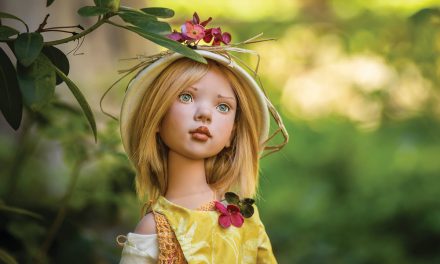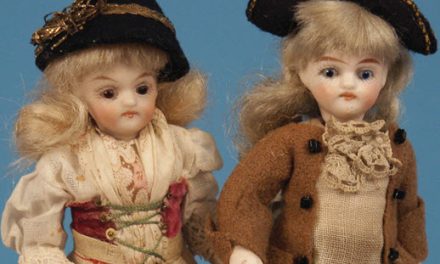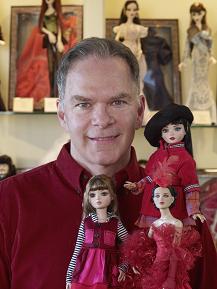Whether it’s her charming marionette dramas, realistic wool animal miniatures, museum-quality oil paintings or porcelain ball-jointed dolls (BJDs), Patricia Cabrera puts every ounce of heart and soul she possesses into creating an enchanted world of art for all to enjoy. Blessed with talent and stamina, Cabrera has a rare and unpretentious sense of joy and peace within herself because there isn’t much she is afraid to tackle in the arts sector.
Until her mid-teens, Cabrera lived with her family on a coffee farm in Bahia, Brazil. “I come from humble beginnings, and no one in my family ever made dolls, but my paternal grandmother was an exquisite seamstress. She taught me how to sew and embroider.”
Since childhood Cabrera has been fascinated with dolls. A precocious, determined girl, she began fashioning her own distinctive dolls from simple paper. In her mind’s eye, she thought her dolls must be able to move about freely, contrasting the typically inanimate, time-honored paper dolls that were unexciting to her. Hence, the youngster strung holes in her primitive constructions to create little marionettes. At 13 Cabrera made her first porcelain dolls from doll kits. She still has them and considers them valued treasures.
Extraordinarily talented as a ballerina, at age15, Cabrera was accepted into the celebrated Miami Ballet Co. and moved to Miami, Fla., to pursue a dancing career. Quickly thrust into the limelight because of her exceptional talent, the young girl had achieved a coveted place in the dance world. But dance was not her heart’s desire for long, Cabrera says. “In my heart I always wanted to get married and be a mother.” To everyone’s amazement in two years, Cabrera gave up the glamorous life of a prestigious ballet dancer to marry the love of her life—her devoted husband Mark. Opting for the life of a wife instead of a ballerina, she eventually became the mother of seven children—Sthefanie, 21; Kathyrine, 16; Kevin, 15; Gabriela, 13; Joshua, 11; Rebecca, 10; and Benjamin, 7—all of whom Cabrera home schools.
In 2002 the Cabreras decided to leave the humid sub-tropical climate of south Florida and move their big, happy family to the milder temperatures of the Tar Heel state. Relocating to a rambling farm snuggled between the lush green valleys and secluded forests of North Carolina, the Cabreras adore the quaint small town (population 384) they live in that sits approximately 45 minutes east of Charlotte and 110 miles from Raleigh—the state capital. True farmers, they raise sheep and chickens. They have a dairy cow named “Hershey” and a sheep dog called “Mattie.”
An artist of many gifts, Cabrera comes from a line of Brazilian artists. Self-taught, she not only enjoys oil painting and sculpting with both wool and polymer clay, she also embroiders, knits and sews—all handwork taught in Brazilian schools and homes. Among a myriad of other interests this busy mother holds dear, Cabrera maintains a small family theater named “The Magical Marionette Theatre” for which she constructs the puppets and performs in shows along with her children. They are regulars on the family feature schedule at Wingate University near Wingate, N.C.
Cabrera has three workshops on the farm’s property: a wood shop fully equipped with a tools and machinery. “This is where I make my doll molds and furniture and do all the assembly work,” Cabrera says. “The next is a pottery shop, where I do all the pouring, sanding and firing. Lastly, is a small sewing room and storage area. I have a lot of supplies so this room serves me well. Even though I have all this space, I still complain about lack of room for everything.”
Cabrera is a present-day pioneer foraging the field of porcelain BJDs in the United States (“porcelain” is the key word here because few, if any, are being made in this country). “Firstly, let me clarify about being the first to make them here in the United States. For the past two years I have done extensive research on BJDs and have found that a few artists have made them; however, none here in the United States. I feel comfortable in saying that PatitaDolls (Cabrera’s company name) is probably the first to offer porcelain BJDs for sale in this country. More importantly,” she goes on, “BJDs are not a new invention. They have merely been recreated and modernized. Only the concept of porcelain BJDs is new, though I do not know who to credit for creating the first one.”
Solely Cabrera’s brainchild, her BJDs are a uniquely articulated ground-breaking system of steel skeletal wiring, which allows for perfect tension and an incredible replica of human movement. Each doll is perfectly proportioned with 14 joints (head/neck; shoulders with arms/elbows/wrists; waist; legs with knees/ankles), all which allow for an infinite range of lifelike poses. The dolls weigh a pound each and are super resilient.
Before coming up with her wiring idea, Cabrera initially threaded her dolls with elastic, but it did not satisfy her and could be perfected, she thought. “In the new version, the skeleton consists of double-twist aircraft-grade tie wire connected by hardened-steel swivel joints and applied tension with steel springs,” she says. “I think I can simplify my idea’s uniqueness in three words: articulation, quality and beauty.”
A newcomer to the professional doll world, the talented artist just started selling her dolls this year. Her creations are available exclusively on her Web site www.patitadolls.com.
“Quality to me means that every doll truly is one-of-a-kind. I only use the best pieces, which could mean creating enough parts to make three dolls but only making one doll from the best parts.” Cabrera is also particular about the painting procedure. Using china paint, this important process requires six to eight layers painted one layer at a time applied between each kiln firing. “This process gives the doll incredible durability and strength,” she says. It takes the inventive dollmaker a minimum of three weeks to create one doll.
Sculpting beautiful dolls has been Cabrera’s goal since she first began to sculpt. She wanted her BJDs to have an innocent beauty that captures the essence of youth. “I think ‘Isabella,’ my first doll, expresses how I feel about that,” she says.
Cabrera’s long-range plans are to attend more doll shows. “Perhaps some international ones,” she says. “But as far as the dolls, I am just enjoying what I am doing right now.”
How Cabrera Makes Her BJDs
“The process of creating a BJD is an intricate recipe requiring technique, precision, craftsmanship and patience. Here are the steps followed when creating a BJD:
1. A sculpted polymer clay prototype (at this stage, all
joints must work perfectly)
2. Plaster mold-making
3. Cast porcelain slip
4. Fire in a ceramic kiln, cone 018 (bisque)
5. Intensive sanding (all details are honed at this stage)
6. Fire again in ceramic kiln at cone 6 (mature firing)
7. China paints
8. Kiln fire cone 018 (bisque)
9. Repeat the step 7 and 8 about 5 more times
10. Leather is attached to joints
11. Steel pins are added at this stage and individually adjusted to allow the doll’s smooth movement. The skeleton consists of double-twist aircraft-grade tie wire connected by hardened-steel swivel joints and applied tension with springs.
12. Wig and costume







